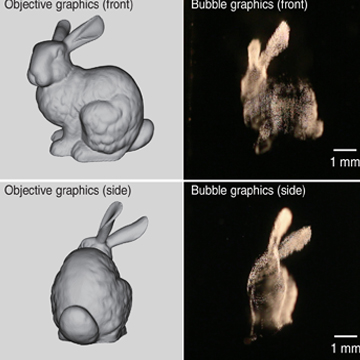
Volumetric graphics of “Stanford bunny” rendered by femtosecond laser-induced microbubbles. [Image: Optica, doi: 10.1364/OPTICA.4.000298]
Researchers from Utsunomiya University, Japan, have designed and demonstrated a new technique for creating 2-D and 3-D images out of laser-generated microbubbles in a liquid volumetric display. An external light source illuminates the images, which are viewable from all angles with the naked eye (Optica, doi: 10.1364/OPTICA.4.000298).
Previously, researchers have struggled to produce a large number of voxels (volumetric pixels) at fast-enough drawing speeds for practical liquid volumetric imaging. The Utsunomiya team, led by Yoshio Hayasaki, claims to have overcome these challenges by using holographic patterns of femtosecond laser pulses to quickly generate microbubble voxels in a viscous glycerin-filled column, slowing the rising speed of the microbubbles.
Holographic laser drawing
The researchers created microbubbles by focusing femtosecond laser pulses on a specific point in the liquid display. Microbubbles formed where photons were absorbed (i.e., multiphoton absorption). However, creating an image point-by-point like this doesn’t work, because the first microbubbles float out of formation before the final microbubbles can be made—even in gooey glycerin.
Hayasaki and his colleagues turned to computer-generated holograms to speed up the process. Their new approach, called holographic laser drawing, uses femtosecond laser pulses to project a computer-generated 2-D or 3-D holographic pattern into the liquid display. Compared with voxels created one by one, the researchers say that holographic laser drawing increased the number of microbubbles per voxel, and boosted the amount of external light scattered by the voxels. Ultimately, this translates to better-defined, brighter images.
Proof-of-concept setup
The researchers’ proof-of-concept volumetric bubble display comprised an amplified femtosecond laser, a light modulator for holographic laser drawing, a glass column filled with glycerin and an external light source to illuminate the images. Using this design, the team created grayscale images of a 2-D mermaid and a 3-D rabbit that remained visible for 30 seconds. They also generated a 2-D image of a dolphin in four different colors by shining white, red, green and blue lights at the display.
The researchers hope that their volumetric bubble display technique will eventually lead to full-color, changeable volumetric displays for a variety of applications, including medical imaging, terrain mapping and art installations.
